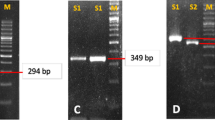Abstract
Helicobacter pylori has been shown to possess a very heterogeneous genoma despite its common phenotypic properties. Some characteristics relevant to pathogenesis have also been found to be heterogeneous. This is the case for adherence properties and the amount of urease produced, but it was not possible to relate these properties to disease entities. A vacuolating cytotoxin which alters epithelial cells has been found in about 60% of strains isolated from patients with ulcers versus 30% from those with gastritis only. ThecagA gene can be used as a marker to detect the cag pathogenicity island. This DNA fragment seems to induce an increased inflammation in the gastric tissue via release of interleukin 8 by the epithelial cells. The association of this marker is strongly linked with ulcers compared with gastritis only (80%vs 55%, respectively). A number of other properties may be heterogeneous, but the low number of strains studied does not allow conclusions to be drawn.
Similar content being viewed by others
References
Mégraud F.H. pylori species heterogenicity. In: Hunt RH, Tytgat GNJ (eds)Helicobacter pylori. Basic mechanisms to clinical cure. Dordrecht. Kluwer Academic 1994:28–40.
Wadström T, Hirmo S, Borén T. Biochemical aspects ofHelicobacter pylori colonization of the human gastric mucosa. Aliment Pharmacol Ther 1996;10(Suppl 1):17–27.
Suzuki M, Miura S, Suematsu M, et al.Helicobacter pylori-associated ammonia production enhances neutrophil-dependent gastric mucosal cell injury. Am J Physiol 1992;263:G719-G725.
Mégraud F, Néman-Simha V, Brügmann D. Further evidence of the toxic effect of ammonia produced byHelicobacter pylori urease on human epithelial cells. Infect Immun 1992;60:1858–1863.
Ito S, Kohli Y, Kato T, et al. Differences in urease activity in liveHelicobacter pylori cultured from patients with gastroduodenal diseases. Eur J Gastroenterol Hepatol 1995;7(Suppl 1):S83-S88.
Leunk RD, Johnson PT, David BC, et al. Cytotoxic activity in broth-culture filtrates ofCampylobacter pylori. J Med Microbiol 1988;26:93–99.
Cover TL, Blaser MJ. Purification and characterization of the vacuolating toxin fromHelicobacter pylori. J Biol Chem 1992;267:10570–10575.
Atherton JC, Cover TC, Peek RM, et al. Typing the vacuolating cytotoxin gene (vacA) ofHelicobacter pylori: Relationship with in vitro cytotoxin acivity and host peptic ulceration (abstract). Gastroenterology. 1995:49.
Ghiara P, Marchetti M, Tummuru MK, et al. Role of theHelicobacter pylori virulence factors vacuolating cytotoxin, CagA, and urease in a mouse model of disease. Infect Immun 1995;63:4154–4160.
Figura N, Guglielmetti P, Russolini A, et al. Cytotoxin production byCampylobacter pylori strains isolated from patients with peptic ulcers and from patients with chronic gastritis only. J Clin Microbiol 1989;27:225–226.
Goossens H, Glupczynski Y, Burette A, et al. Role of the vacuolating toxin fromHelicobacter pylori in the pathogenesis of duodenal and gastric ulcer. Med Microbiol Lett 1992;1:153–159.
Cover TL, Dooley CP, Blaser MJ. Characterization and human serologic response to proteins inHelicobacter pylori broth-culture supernatants with vacuolizing cytotoxin activity. Infect Immun 1990;58:603–610.
Tee W, Lambert JR, Pegorer M, et al. Cytotoxin production byHelicobacter pylori is more common in peptic ulcer disease (abstract). Gastroenterology 1993;104:A789.
Decross AJ, Barrett LJ, Guerrant RL, et al. The vacuolating cytotoxin ofHelicobacter pylori: Comparing isolates from duodenal ulcer and non-ulcer dyspepsia patients (abstract). Digestive Diseases Week, Boston 1993:A2366.
Crabtree JE, Taylor JD, Wyatt JI, et al. Mucosal IgA recognition ofHelicobacter pylori 120kDa protein peptic ulceration and gastric pathology. Lancet 1991;338:332–335.
Covacci A, Censini S, Bugnoli M, et al. Molecular characterization of the 128-kDa immunodominant antigen ofHelicobacter pylori associated with cytotoxin and duodenal ulcer. Proc Natl Acad Sci USA 1993;90:5791–5795.
Crabtree JE, Covacci A, Farmery SM, et al.Helicobacter pylori-induced interleukin-8 expression in gastric epithelial cells is associated with CagA-positive phenotype. J Clin Pathol 1995;48:51–55.
Tummuru MK, Sharma SA, Blaser MJ.Helicobacter pylori picB, a homolog of theBordetella pertussis toxin secretion protein, is required for induction of IL8 in gastric epithelial cells. Mol Microbiol 1995;18:867–876.
Lange N, Censini S, Xiang Z, et al. The cagA chromosomal region ofHelicobacter pylori is type I specific and encodes exporter molecules and invasion genes. In: Proceedings of the 8th International Workshop on Campylobacters, Helicobacters, and related organisms. Winchester, UK. E2/3, 1995.
Akopyants NS, Kersulyte D, Berg DE. CagII, a new multigene locus associated with virulence inHelicobacter pylori (abstract). Gut 1995;37(Suppl 1):A1.
Labigne A, Lamouliatte H, Birac C, et al. Distribution of thecagA gene amongHelicobacter pylori strains associated with peptic ulcer. Am J Gastroenterol 1994;89:8 (abstract 166).
Lage AP, Godfroid E, Fauconnier A, et al. Frequency ofcagA inHelicobacter pylori strains isolated from Belgian and Moroccan patients. Gut 1995;37:A69 (abstract 273).
Rudi J, Maiwald M, Hagelstein J, et al. High prevalence of serum antibodies to the 128 Kda protein (Cag A) in gastric cancer patients infected withH. pylori (abstract). Gut 1995;37(Suppl 2): 96.
Rautelin H, Blomberg B, Fredlund H, et al. Incidence ofHelicobacter pylori strains activating neutrophils in patients with peptic ulcer disease. Gut 1993;34:599–603.
Segal E, Falkow S, Tompkins LS.Helicobacter pylori attachment to gastric cells induces cytoskeletal rearrangements and tyrosine phosphorylation of host cell proteins. Proc Natl Acad Sci USA 1996;93:1259–1264.
Micots I, Augeron C, Laboisse DL, et al. Mucin exocytosis: A major target forHelicobacter pylori. J Clin Pathol 1993;46:241–245.
Mégraud F. Toxic factors ofHelicobacter pylori. Eur J Gastroenterol Hepatol 1994;6(Suppl 1):S5-S10.
Courillon-Mallet A, Launay JM, Roucayrol AM, et al.Helicobacter pylori infection: Physiopathologic implication of N-alpha-methylhistamine. Gastroenterology 1995;108:959–966.
Author information
Authors and Affiliations
Rights and permissions
About this article
Cite this article
Mégraud, F. Pathogenic diversity ofHelicobacter pylori . J Gastroenterol 32, 278–281 (1997). https://doi.org/10.1007/BF02936383
Received:
Accepted:
Issue Date:
DOI: https://doi.org/10.1007/BF02936383




